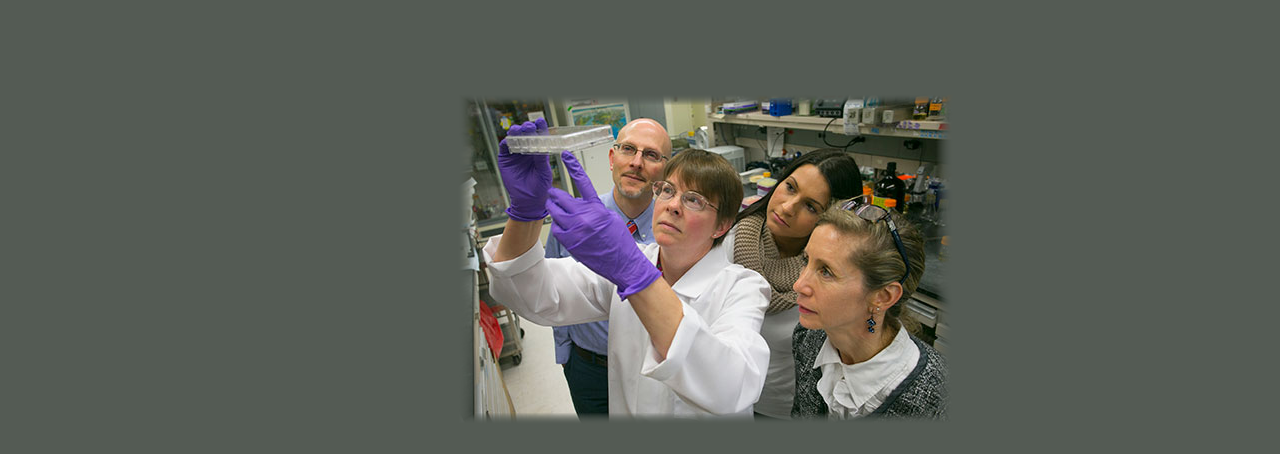Many hands make light work
Courtesy of Stony Brook University
When we think of inventors, most of us picture a bespectacled scientist in a shiny laboratory or a solitary engineer hunched over a cluttered workspace. But sometimes the visual looks more like a table full of new friends, sharing a laugh and some coffee. That’s how Annie Rohan, the director of pediatric research at Stony Brook University School of Nursing, describes the groups that came together from across campus to develop an innovative device; a phototherapy-integrated catheter that could solve a multimillion-dollar problem in healthcare.
Catheters – especially the urinary variety – are used extensively by hospital providers, but generally do little to prevent the infections with which they are associated. The phototherapy-integrated device goes beyond the traditional concept and is designed to fight catheter-associated urinary tract infections (CAUTIs) while dwelling in a patient. Rohan said its secret weapon is a light-emitting diode, or LED, the same type of device used to generate light in everything from headlights to computer monitors. Certain wavelengths of LED-emitted light have powerful antimicrobial effects, so are used to treat skin infections or to sterilize equipment. The idea of adding light to catheters isn’t new, but to date, there hasn’t been a product that can successfully reduce infection risk once the device is in the body, Rohan said.
The Nurse Innovator
The idea began in 2014 with Charles Davis, who at the time was a student in the School of Nursing. With a PhD in materials science, Davis already had a career of more than 20 years in scientific research at IBM. While learning about the prevalence of hospital-acquired infections, Davis set out to devise ways to solve the problem. He had worked with LEDs at IBM and knew of their bacterial power. Could a catheter be combined with LEDs to combat the UTI-causing bacteria? He knew it could have significant impact if the details could be worked out.
“To have a device that greatly diminished the likelihood of a UTI would have universal benefits if it can be done cheaply and with minimal issues for the patient,” he said.
He took his idea to Lee Anne Xippolitos, dean of the School of Nursing. Knowing that Davis would need help to move the idea forward, Xippolitos said she immediately thought of Rohan.
“I met her when she was a nurse practitioner in the NICU (Neonatal Intensive Care Unit),” Xippolitos said. “After she finished her PhD and joined the faculty, I knew she was interested in clinical and biotechnological research. So I put the two of them in touch.”
The Team
Rohan said she was familiar with the idea of using lights therapeutically after seeing so many newborns exposed to bilirubin lights to combat jaundice. After some discussion of the concept, Rohan and Davis got to work on the details.
The first step was to consult with Stony Brook’s Department of Physics to help determine how the light could be produced in a therapeutic wavelength. Next, to see how it would affect the bacteria associated with UTIs, they turned to David Thanassi, a professor in the Department of Molecular Genetics and Microbiology and the Center for Infectious Diseases.
The group submitted a project proposal, “A Novel Medical Catheter with Light-Emitting Diodes,” to the State University of New York‘s Technology Accelerator Fund program and were rewarded with grant monies for further their research. Additional funds came through a Stony Brook University School of Medicine TRO-FUSION award, designed to support interprofessional, highly meritorious and innovative research focusing on the biomedical discovery, health and the community,
Soon more people were coming to the table. Students from the Department of Chemistry and School of Medicine joined the discussion. Experts from the Center for Biotechnology were pulled in to advise about marketing the end result.
Looking Ahead
With so much research behind them, the team know has a prototype in the works. When that is finished, it will move into a testing phase to determine its readiness for animal testing.
Thanassi said that the interdisciplinary culture at Stony Brook has been key to the project’s success. “I always promote to others coming here what a collaborative environment Stony Brook is,” he said. “They are very encouraging of projects that involve reaching out to other departments.”
Kenneth Kaushansky, MD, MACP, dean of the School of Medicine and senior vice president of health sciences, said he is pleased with what this project represents. “It epitomizes what we hope to continue to accomplish at Stony Brook Medicine. It’s very clear that medicine and biomedical science are a team sport, and having an environment that allows this kind of teamwork is exactly why we are here. I could not be more proud.”
comments powered by Disqus


